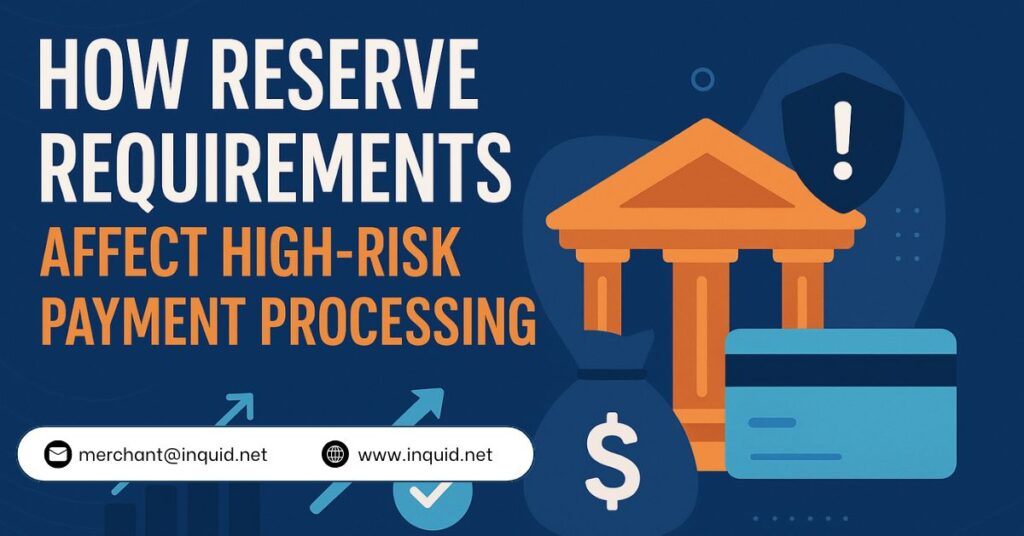
High-risk merchants often face extra hurdles when it comes to payment processing. One of the most debated requirements is the reserve that processors and acquiring banks hold back. While it may feel like a burden, reserve requirements in high-risk payment processing are central to how providers manage risk in flagged industries. Understanding how these requirements work can help merchants plan better and avoid cash flow surprises.
What Are Reserve Requirements?
A reserve requirement is when the payment processor withholds a percentage of a merchant’s sales to cover potential risks such as chargebacks, refunds, or fraud. Instead of being transferred to the merchant right away, these funds are kept aside for a set period.
For high-risk industries such as forex, gaming, adult, nutraceuticals, and subscription-based services, reserves act as a financial buffer for processors. They reduce the likelihood of losses in case transactions turn out to be disputed or fraudulent.
Types of Reserves in Payment Processing
Not all reserves are structured the same way. Merchants may encounter:
- Rolling Reserve: A set percentage of each transaction is held for a few months before being released.
- Upfront Reserve: A lump sum is withheld at the start of processing.
- Fixed Reserve: A specific amount is maintained in the account as a safety net.
Each model affects cash flow differently, but rolling reserves are the most common for high-risk payment processing.
Why High-Risk Merchants Face Higher Reserve Rates
Reserve requirements are often stricter for merchants in high-risk categories. The main reasons include:
- Chargeback Volume: Industries like online gaming or travel tend to have higher chargeback rates.
- Regulatory Scrutiny: Certain sectors face tougher regulations, which raise concerns for processors.
- Business Stability: Newer businesses or those with inconsistent transaction history are viewed as riskier.
This is why two merchants in the same industry may be offered different reserve percentages. Factors such as processing history, average ticket size, and monthly volume play a big role in how the requirement is set.
Impact on Cash Flow and Business Growth
Reserves can directly affect how fast a business grows. A 10% rolling reserve, for instance, means the merchant only receives 90% of their revenue immediately. While the withheld amount is eventually released, it may take 3–6 months to access those funds.
For businesses with tight operating budgets, this delay can limit marketing spend, payroll flexibility, or expansion plans. Many merchants underestimate how significantly reserves shape their day-to-day cash flow until they start processing payments.
Managing Reserve Requirements Effectively
Even though reserves are unavoidable for high-risk merchants, there are strategies to manage them:
- Maintain Low Chargebacks: Keeping disputes under control is the fastest way to negotiate better reserve terms. Following proven high-risk payment processing tips helps in this area.
- Build Processing History: Over time, strong performance records allow merchants to request lower reserve percentages.
- Work with the Right Provider: Not all payment processors apply the same requirements. Some are more flexible in working with high-risk merchants.
- Plan Cash Flow: Setting aside working capital can prevent reserves from disrupting operations.
Why Transparency Matters with Providers
One mistake merchants often make is not discussing reserves openly during setup. Asking clear questions about reserve percentages, release periods, and adjustment policies ensures there are no surprises later. A transparent processor should provide written terms and help merchants understand how reserve funds will be handled.
The Future of Reserve Policies in High-Risk Processing
With advancements in fraud detection and AI-driven risk monitoring, some experts believe reserve requirements may become more flexible over time. However, high-risk merchants should still expect them to remain part of payment processing contracts for the foreseeable future. For businesses entering these industries, planning for reserves upfront is essential.
Final Thoughts
Reserves are not just a hurdle; they are part of the trade-off for accessing global payment networks as a high-risk merchant. By understanding how they work and preparing strategies to manage them, businesses can reduce friction and maintain steady growth.
If you’re navigating high-risk payment processing and want advice on reserves or approval strategies, the team at inquid can help.
FAQs on Reserve Requirements in High-Risk Payment Processing
1. Why do payment processors impose reserves on high-risk merchants?
Reserves protect processors from potential losses caused by chargebacks, fraud, or sudden business closures. They act as a financial safety net when dealing with risk-heavy industries.
2. How long are reserve funds typically held?
Most rolling reserves are held for 90 to 180 days, though this depends on the processor’s policy and the merchant’s risk profile.
3. Can reserve requirements be negotiated?
Yes. Merchants with a solid processing history, low chargeback ratios, and stable business operations can request lower reserve percentages over time.
4. Do all high-risk industries have the same reserve rates?
No. Reserve percentages vary based on industry, business size, monthly volume, and overall risk exposure. A forex merchant may face different requirements than a subscription-based service.
